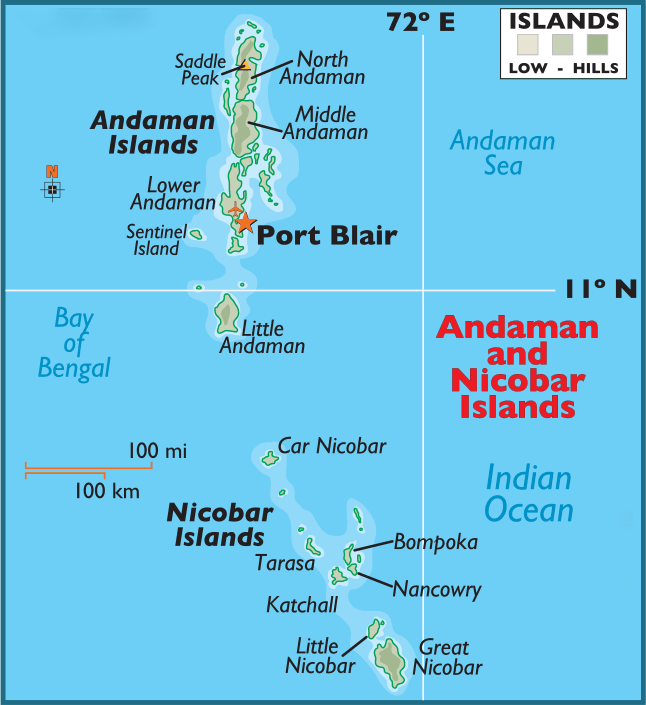Biodiversity & Environment
Great Nicobar Island Project
- 10 Apr 2023
- 7 min read
For Prelims: National Green Tribunal (NGT), Great Nicobar Island, Coastal Regulation Zones, Turtles, Dolphins, Particularly Vulnerable Tribal Groups (PVTGs), Mangroves, Great Nicobar Biosphere Reserve.
For Mains: Significance and Issues Related to Great Nicobar Island Project.
Why in News?
The National Green Tribunal (NGT) has issued a stay on the Great Nicobar Island project worth ₹72,000 crore and created a committee to review the environmental clearance granted by the Ministry of Environment, Forest and Climate Change.
What is the Great Nicobar Island Project?
- About:
- The Great Nicobar Island (GNI) Project is a mega project to be implemented at the southern end of the Andaman and Nicobar islands.
- The project includes an international container transshipment terminal, a greenfield international airport, township development, and a 450 MVA gas and solar based power plant over an extent of 16,610 hectares in the island.
- Purpose:
- Economic Reasons:
- As per the NITI Aayog report, the proposed port will allow Great Nicobar to participate in the regional and global maritime economy by becoming a major player in cargo transshipment.
- It is equidistant from Colombo to the southwest and Port Klang (Malaysia) and Singapore to the southeast, and positioned close to the East-West international shipping corridor, through which a very large part of the world’s shipping trade passes.
- As per the NITI Aayog report, the proposed port will allow Great Nicobar to participate in the regional and global maritime economy by becoming a major player in cargo transshipment.
- Strategic Reasons:
- The proposal to develop Great Nicobar was first floated in the 1970s, and its importance for national security and consolidation of the Indian Ocean Region has been repeatedly underlined.
- Increasing Chinese assertion in the Indian Ocean has added great urgency to this imperative in recent years.
- Economic Reasons:
- Criticism:
- Impact on Biodiversity:
- The project has faced several criticism citing concerns regarding its adverse impact on the rich biodiversity of the area and damage to the habitats of endangered species.
- The project area is part of Coastal Regulation Zones-IA and IB, and the Galathea bay which is a nesting ground for birds.
- Also, turtle nesting sites, dolphins and other species will be harmed by dredging.
- The project has faced several criticism citing concerns regarding its adverse impact on the rich biodiversity of the area and damage to the habitats of endangered species.
- Impact on Tree Cover and Mangroves:
- Environmentalists have also flagged the loss of tree cover and mangroves on the island as a result of the development project.
- The loss of tree cover will not only affect the flora and fauna on the island, it will also lead to increased runoff and sediment deposits in the ocean, impacting the coral reefs in the area.
- Lack of Adequate Assessment:
- Critics claimed that only one season data has been taken, as opposed to the requirement of taking data for three seasons for comprehensive impact assessment, environmental impact assessment reports were not conducted as per Terms of Reference (ToR).
- Encroachment in Tribal Space:
- Critics argue that while Particularly Vulnerable Tribal Groups (PVTGs) are accorded the highest level of protection by local administration, they still face numerous challenges due to encroachment into their areas in the name of development.
- Impact on Biodiversity:
Great Nicobar
- About:
- Great Nicobar is the southernmost island of the Nicobar Islands Archipelago.
- It covers 1,03,870 hectares of unique and threatened tropical evergreen forest ecosystems.
- It is home to a very rich ecosystem, including 650 species of angiosperms, ferns, gymnosperms, bryophytes, among others.
- In terms of fauna, there are over 1800 species, some of which are endemic to this area.
- Great Nicobar is the southernmost island of the Nicobar Islands Archipelago.
- Ecological Characteristics:
- The Great Nicobar Biosphere Reserve harbours a wide spectrum of ecosystems comprising tropical wet evergreen forests, mountain ranges reaching a height of 642 m (Mt. Thullier) above sea level, and coastal plains.
- Tribe:
- The Mongoloid Shompen Tribe, about 200 in number, live in the forests of the biosphere reserve particularly along the rivers and streams.
- They are hunters and food gatherers, dependent on forest and marine resources for sustenance.
- Another Mongoloid Tribe, Nicobarese, about 300 in number, used to live in settlements along the west coast.
- After the tsunami in 2004, which devastated their settlement on the western coast, they were relocated to Afra Bay in the North Coast and Campbell Bay.
- The Mongoloid Shompen Tribe, about 200 in number, live in the forests of the biosphere reserve particularly along the rivers and streams.
Conclusion
- The NGT's order to stay the Great Nicobar Island project and constitute a committee to review the environmental clearance aims to ensure that the project is compliant with the Island Coastal Regulation Zone 2019 and tribal rights.
UPSC Civil Services Examination, Previous Year Questions (PYQs)
Q1. Which one of the following pairs of islands is separated from each other by the ‘Ten Degree Channel’? (2014)
(a) Andaman and Nicobar
(b) Nicobar and Sumatra
(c) Maldives and Lakshadweep
(d) Sumatra and Java
Ans: (a)
Q2. Which of the following have coral reefs? (2014)
- Andaman and Nicobar Islands
- Gulf of Kachchh
- Gulf of Mannar
- Sunderbans
Select the correct answer using the code given below:
(a) 1, 2 and 3 only
(b) 2 and 4 only
(c) 1 and 3 only
(d) 1, 2, 3 and 4
Ans: (a)
Q3. In which one of the following places is the Shompen tribe found? (2009)
(a) Nilgiri Hills
(b) Nicobar Islands
(c) Spiti Valley
(d) Lakshadweep Islands
Ans: (b)





